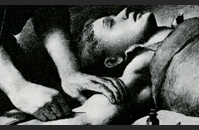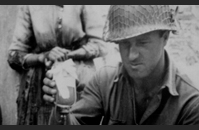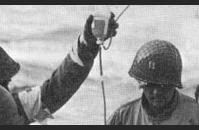LESSON PLAN:
A New War Weapon to SAVE Lives: Blood Plasma
Major advances in medical technology were made during WWII, including the use of blood plasma transfusions to save lives on the battlefield. Investigate the three major antigen types present on the surface of human red blood cells. Relate the complexity of blood typing prior to transfusion and the solution of using blood plasma to treat trauma on the front lines during WWII.
Objectives:
Students will:
- Learn about blood transfusion by analyzing a photograph and interpreting the meaning of print materials.
- Think critically about the challenges collecting, preserving and transporting blood for transfusions and recognize the role of collaboration in scientific undertakings.
- Recognize the three human blood antigens, the determination of blood type and the phenomenon of agglutination during transfusions.
Grade Level: 9-12
Standards:
NGSS HS-LS1-2 - Develop and use a model to illustrate the hierarchical organization of interacting systems that provide specific functions within multicellular organisms.
CCSS.ELA-Literacy.CCRA.R.2 - Determine central ideas or themes of a text and analyze their development; summarize the key supporting details and ideas.
CCSS.ELA-Literacy.CCRA.R.7 - Integrate and evaluate content presented in diverse media and formats, including visually and quantitatively, as well as in words.
CCSS.ELA-Literacy.CCRA.R.9 - Analyze how two or more texts address similar themes or topics in order to build knowledge or to compare the approaches the authors take.
NCHS Historical Thinking Standard 2D - Differentiate between historical facts and historical interpretations.
Time Requirement: 75-90 Minutes
Materials:
Copies (paper or digital access) of the primary sources, the fact sheet, and the student activity sheet.
4 clear plastic cups filled with water, blue and red food coloring.
Prior Knowledge: This lesson can correspond with the exploration of the anatomy and physiology of the circulatory system, specifically the composition of blood and red blood cell antigens. During a genetics unit, this lesson can be used to explore the real-life application of the inheritance of blood types.
Introduction: Show students the primary source, obscuring the caption. Display on a video projector, overhead projector or make copies for students to share. Use some or all of the questions to lead an introductory discussion about the history of the development of blood donation, blood transfusions and the use of blood plasma in treating shock. Hints are given after some questions in parentheses to help move the discussion forward.
Primary Sources:
Leading Discussion Questions:
- Take a look at the photograph. What is happening in the picture? (Hints for students: notice the helmeted soldier, the patient’s shirt is open, the men’s positions, the worried expressions of the women in the background, and the discarded helmet on the left of the image.)
- Who are these men? (Look at the clothing and equipment, the medic’s arm band and dog tags.)
- When and where do you think it was taken? (In a village, notice the children and women’s clothing, lack of shoes, the dirt pathway.)
- What so you think is in the bottle held up by the soldier second from the left? (The liquid is clear and a large volume connected to the injured soldier through a tube. Students may think that this is medicine which would likely be dosed by syringe, not a drip line.)
- Describe what you see in the background of the photograph. (Notice the discarded helmet at the far left, explore the presence of civilians including women and children during war.)
Directions:
1. Reveal the caption. Have students read and discuss their reactions to the photograph before and after reading the caption.
2. Distribute copies of the Owens-Corning Fiberglas advertisement, “A new war weapon to save lives.” You may choose for your students to read individually, as a small group or as a class. Stop periodically to answer questions and clarify any terms from the reading.
3. Demonstrate blood type compatibility using the four cups of water. Label cups with the four human blood types, A, B, AB, and O. Add blue food coloring to represent type A blood. Add red food coloring to represent type B blood. Add blue and red to represent type AB blood. Add no food coloring to the type O cup.
4. Ask your students to predict what will happen when each blood type is donated to the other three types. You may choose to do this as a whole group activity, small group activity, or individual activity. Discuss the predictions as a class.
5. Combine the colored liquids to see the results. You may want to use additional cups during the demonstration.
6. Discuss the results on the demonstration, focusing on the antigen/antibody reaction. Ask students to differentiate between the transfusion of whole blood and the transfusion of plasma.
7. Distribute the Fact Sheet for students to read. You may choose for your students to read individually, as a small group, or as a class. Stop periodically to answer questions and clarify any terms from the reading.
8. Give the Student Activity Sheet to assess understanding of the reading and demonstration.
Assessment:
Components for assessment include the student activity sheet, classroom discussion, and formative assessment.
Enrichment:
Listen to WWII oral histories about segregated medical treatment and blood storage using The Digital Collections of The National WWII Museum, especially Segment 4 of Daniel Inouye’s interview.
Debate discriminatory blood banking policies and conduct additional research to determine when these practices came to an end. Does discriminatory medical treatment still exist?
Materials for Download
Instructions
Primary Sources
Fact Sheet
Student Activity Worksheet
TAKE ACTION:


EDUCATION PROJECTS:
Student Travel – WWII Educational Tours
High school and college students, learn the leadership principles that helped win WWII on a trip to France or during a weeklong residential program in New Orleans. College credit is available, and space is limited.
See You Next Year! HS Yearbooks from WWII
Collected from across the United States, the words and pictures of these yearbooks present a new opportunity to experience the many challenges, setbacks and triumphs of the war through the eyes of America’s youth.
The Victory Gardens of WWII
Visit the Classroom Victory Garden Project website to learn about food production during WWII, find lesson plans and activities for elementary students, get tips for starting your own garden and try out simple Victory Garden recipes!
The Science and Technology of WWII
Visit our new interactive website to learn about wartime technical and scientific advances that forever changed our world. Incorporates STEM principles to use in the classroom.
Kids Corner: Fun and Games!
Make your own propaganda posters, test your memory, solve puzzles and more! Learn about World War II and have fun at the same time.






